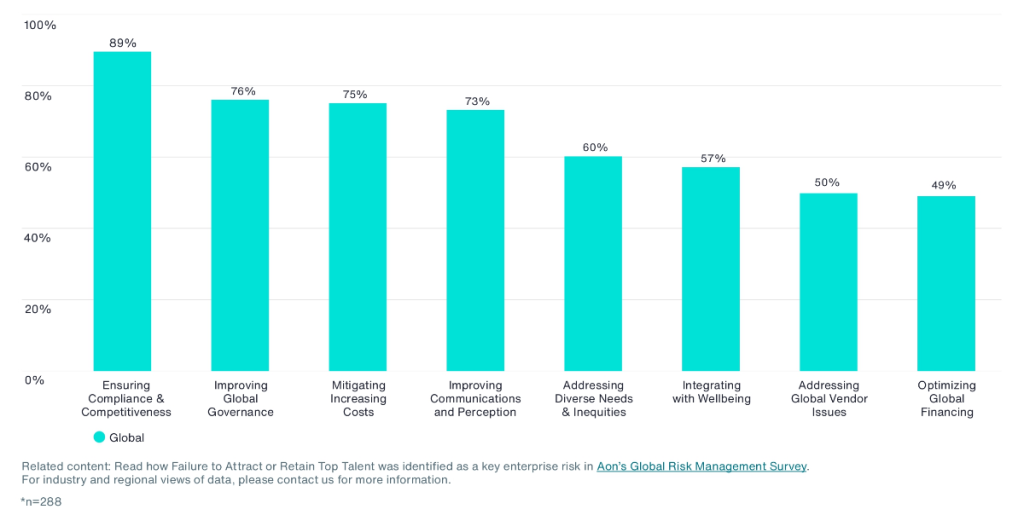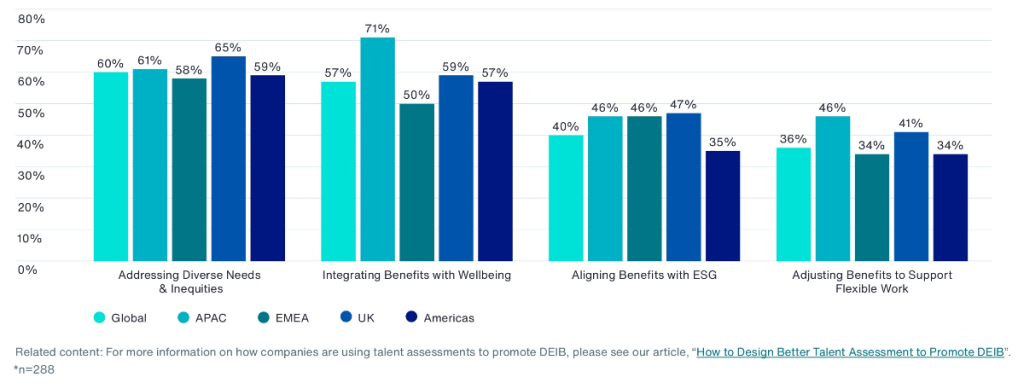
With talent attraction and retention an ongoing challenge, and the call for more attention on employees’ wellbeing, companies have been relooking their internal priorities and policies to cater to new and emerging needs. From generous benefits that span annual, maternity/paternity and childcare leave to workplace wellness facilities, fully-stocked pantries and relaxation areas or nap rooms; from ergonomic office furnishings to office location and a strong technology infrastructure, companies are pulling out the stops to take care of their employees.
A recent survey by global professional services firm Aon shows that global minimum benefits standards are fast becoming the new normal for multinational companies (MNCs). The survey, 2024 Global Benefits Trends Study, gathered insights about the evolving roles, responsibilities and priorities of benefits professionals in MNCs amid a constantly evolving global benefits (GB) landscape. The study finds that continually rising benefits costs, shifting perceptions of employee mobility, pay transparency and equity mandates, the role of technology in supporting company culture, and employee engagement are just a few forces at play.
According to Aon, one of the significant findings of the survey is also the shifting function of the GB professional. No longer are GB professionals limited in scope to the administration of the benefits programme or management of specific geographies. Instead, GB professionals are taking on a more centralised and strategic role as the architects and stewards of the benefits programme that firms are offering to employees. The report identifies various areas where this functional shift presents opportunities, challenges and a potential realignment of priorities for GB professionals.
In recent years, diversity, equity, inclusion and belonging (DEIB); environment, social and governance (ESG); and the future of work may have been hogging the headlines, but the Aon study shows that on a global basis, these topics rank as mid-level critical priorities for MNCs, behind compliance/competitiveness, cost management, governance and communication. Company priorities also differ across the regions surveyed, comprising North and South America; Europe, Middle East and Africa (EMEA), Asia Pacific (APAC), and the United Kingdom (UK).
Strategic priorities: Where multinationals are focusing their energy

Strategic priorities influencing minimum benefits standards

In APAC, organisations generally embrace DEIB and wellbeing more than in other regions, with 71% saying wellbeing is a current strategic priority. Organisations in APAC also rate, as a high priority, how benefits support the future of work and flexible work.
Employee wellbeing is certainly a key priority in Singapore. In studies on the Singapore workforce, flexible work arrangements have consistently ranked high on their priority list. Having had a taste of work-from-home during the COVID-19 pandemic, employees now want a better work-life balance through flexible work arrangements. The government is fully onboard, and the Ministry of Manpower has released the Tripartite Statement on Flexible Work Arrangements to guide companies in implementing flexible work arrangements.

Globally, the most prevalent minimum benefits standards that companies currently offer are employee assistance programmes and life insurance (73%), maternity leave (70%), and paternity leave (69%). These standard offerings support strategic priorities such as DEIB, employee wellbeing, ESG, and holistic wellbeing.
The survey also notes that globally, one in three MNCs is currently drafting and articulating their global benefits strategy and reviewing it annually. Growing trends like DEIB, employee wellbeing and ESG are contributing to this more frequent cadence.
Organisations have progressed from lip service to actual action. Their strategies are becoming more detailed, with many of them (64%) sharing that they have articulated detailed design principles.
However, the survey reveals a gap in the implementation of strategy at the local level, which leads to an inconsistent employee experience.
Some 59% of organisations surveyed say they are including employee feedback and perspectives, to guide strategic priorities.
Many businesses from the study have stated that communication and increasing the perceived value of benefits is a consistent top strategic priority today.
However, while businesses say that employee perception and understanding of benefits is a high priority, current efforts are found to be underwhelming, uncoordinated and ineffective. Only 33% include guidelines on communication in their global framework. In addition, the vast majority of businesses (72%) are leaving communication to the local benefits teams, leading to an inconsistent experience around the world.
The Aon survey was conducted from March to April 2024, and received responses from participants in 31 countries across North and South America; EMEA, APAC and the UK. The intent of the study was to understand the global benefits trends associated with multinationals around the world, and to gather insights about the roles, responsibilities and evolving priorities of GB professionals in MNCs. You can read the full report here.